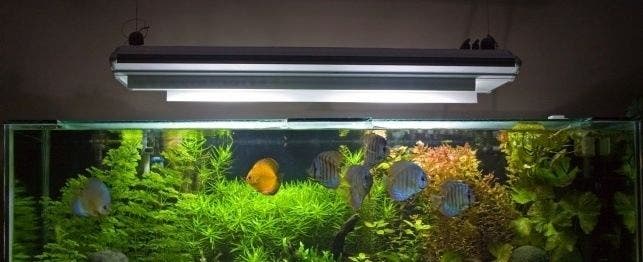
Lighting Your Aquarium
If you think your choice of fish tanks has grown more difficult in recent years – long, tall, rectangular, hexagonal, glass, Plexiglass – your choice of lighting is not much easier. While once the only choice was incandescent vs. fluorescent, you can now choose the spectrum of light you want from full to partial, from red/blue to green, compact vs. regular; there are daylight tubes, plant-growth tubes, actinic tubes and reflector tubes.
All of these lights are meant to accomplish one thing: Supply your fish and plants with a substitute for natural sunlight. Most aquarium species live in waters shallow enough to be penetrated by sunlight. Because most fish in your tank come from the tropics they are used to 12 hours of daylight. Green aquarium plants, like garden plants, require sunlight for photosynthesis. In marine aquariums, invertebrates such as anemones and mollusks have special light needs in order to survive. Artificial lighting is necessary because natural sunlight is too unreliable for most aquarium setups.
Avoid Incandescent Light
To begin with, incandescent light is probably the least desirable choice. While incandescent lamps are cheap and bright, they also generate a great deal of heat. Unless the time that they are on is carefully regulated, they will heat up a fish tank quickly and ruin all your efforts to control the temperature. Halogen lamps, which are a form of incandescent lamps, will last longer but they, too, produce a lot of heat.
Fluorescent lighting is far more efficient and produces little heat. In addition, they no longer throw off the greenish glow familiar to anyone who works in a fluorescent-lighted office. Warm white and cool white bulbs add a bit more range to the light, and for a tank with fish and no live plants they should be sufficient. The recommended wattage is 2 to 4 watts per gallon of water. Two tank-length 15-watt fluorescent bulbs are suitable for a 10-gallon tank. Many aquarium hoods are equipped to hold fluorescent tubes. Screw-in type fluorescent tubes can be used in hoods fitted for incandescent bulbs. If the underside of the hood is made of a reflective material, the light coming into the tank will be stronger. Remember, though, that too much brightness can keep shy fish in hiding.
You may be able to grow some plants under these conditions. Some ferns, for example, require lesser amounts of light. However, most plants will require a bulb that delivers a fuller spectrum of light. Here, full-spectrum bulbs such as Vitalite, among others, come as close as chemically possible to imitating the natural spectrum of sunlight. These tubes cost $8 to $20 each. Tri-phosphor tubes are very bright and concentrated in the red, blue and green ranges of the spectrum. Metal Halide or MH tubes are very high intensity and last longer than fluorescents but they generate heat. Compact fluorescent lights are narrow versions of the familiar fluorescent tube. They are very bright, and also last longer than regular fluorescents. Some aquarists combine MH with compact fluorescent lights for a look as natural as sunlight in the aquarium. Reflector tubes intensify and direct the light but the cost far outweighs the benefits to the aquarium.
This covers the basics. The choices available in your aquarium shop will still dazzle you. Fluorescent tubes designed specifically for aquarium use may be expensive without giving you a great deal more in the way of effective light. Since the tubes must be changed regularly, it might be worth trying out different kinds of tubes and combinations and seeing which give you the best results, both in enhancing the colors of your fish and in increasing the growth of your plants. (Except for the compact fluorescents, regular fluorescent lights will need to be replaced within 6 to 8 months. Even though the light may not appear any dimmer to you, the amount of light being output declines significantly long before the tube burns out.)